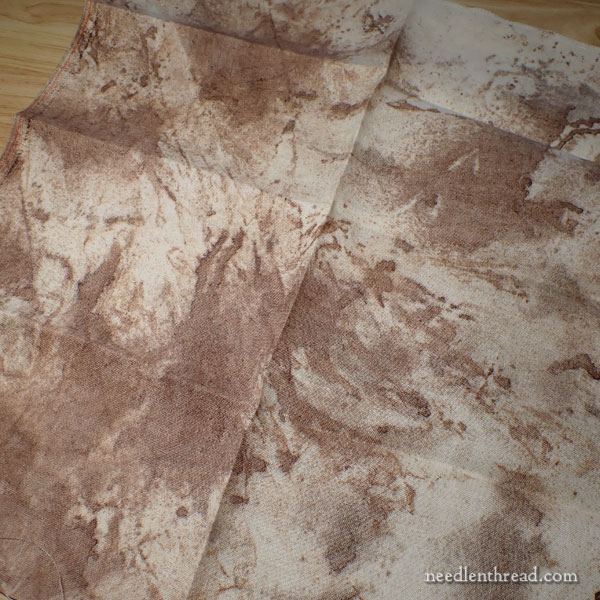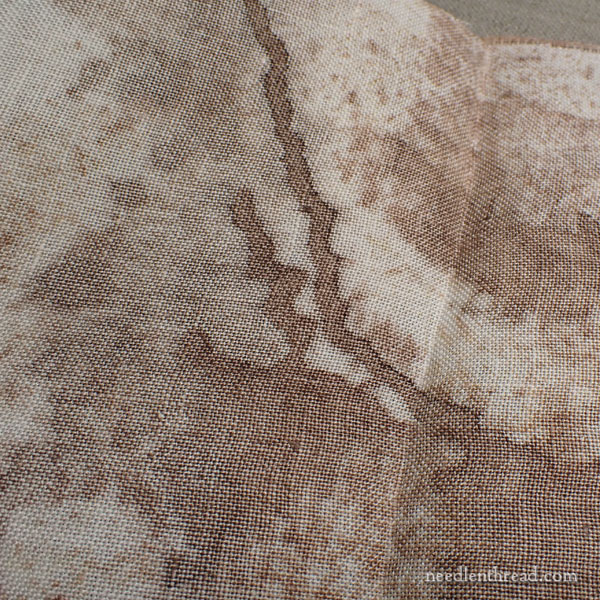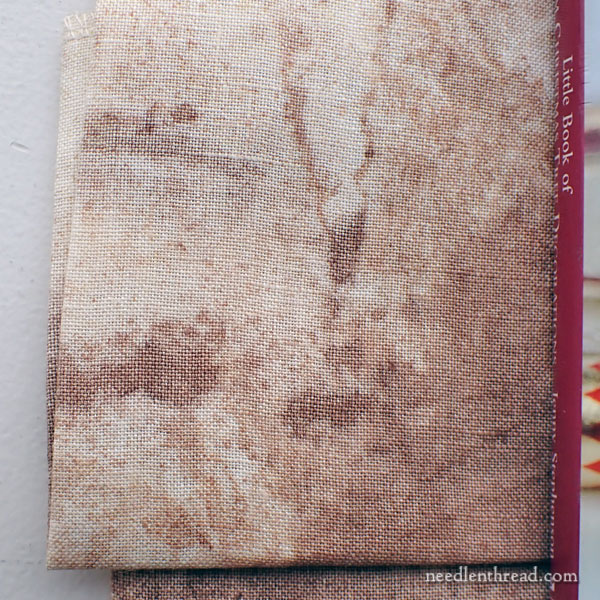Well, I have a piece of linen that came to me from origin unknown. It’s a Mystery!
I like mysteries. I’m pretty sure this one involves murder and mayhem, based on the piece of linen.
I’m curious about the linen and what people think of it. And apparently, so is the original owner of it.
I have a feeling I’m going to be sticking my neck Way Out and ruffling some feathers here. It’s not my intention.
Let me clarify: I don’t know everything going on in the needlework world. So if this is some big project out there, social media thing, mystery stitch-along, or what-have-you, well… beats me. I don’t know all the details!
But I can give some thoughts that occurred to me about the linen, since that’s what I was asked to do.
And since the question of using overdyed linen comes up a lot in my inbox, I figure I might as well take the opportunity to write about it. I’m going to do that in a meandering way, so bear with me! There’s a point in here somewhere.

First of all, overdyed linen. What is it? It’s linen that’s been hand dyed, usually in a way that involves one or more colors on another (base) color, the results of which can range from slightly mottled to downright blotchy. Overdyed linens can be super colorful, they can be calmly subtle and monochromatic – it just depends on the overall process, colors used, outcome desired, and so forth.
Very generally, then, overdyed linen is hand dyed, there’s normally a mottled look to it, and it can add interest and depth, excitement, and variation to needlework, mixed media projects, and the like.
Am I opposed to overdyed linen? No. It has its place, like everything.
Would it matter to you if I were opposed to it? It shouldn’t. If you like it, use it! If you don’t like it, don’t!
But there are some things to consider when using overdyed linen. These points can apply, really, to choosing any ground fabric used for embroidery. So I’ll talk about them below.

First of all, consider what you are making and its purpose.
In this case, if you’re involved in some kind of murder mystery stitch along, and the piece that you’re making requires a background that looks like it cleaned up a crime scene, then I don’t think you could find better looking linen for the job! It would be perfect for something like that!
I would imagine that you’re not expecting the piece to be heirloom quality, that you’re not necessarily expecting it to withstand the test of time (I don’t know that people would “get it” 20, 50, or 100 years from now, when trends have changed), and that it’s something you’re doing for the sheer fun of it.
Needlework, after all, is something we pursue because it gives us pleasure.
Point #1: What are you stitching? Does the ground fabric – overdyed or not – contribute to the outcome you want, that will give you pleasure? Is this a Piece for All Time, or a Piece of the Hour? Do you expect the result to be an heirloom quality piece that transcends time?
These are things you have to consider when you choose ground fabric. And then ask yourself, “Will this fabric do it for me?”

Point #2: Do you like it?
From what I know about this piece of fabric – which isn’t much – I’m guessing the person doesn’t like it (or at least, not for its intended use).
If your concern is that you’re going to be putting a lot of time (and perhaps money – after all, threads can be expensive, memberships can be expensive, etc.) into this project, that the fabric is going to interfere with your expected or desired outcome, that you are going to lose a lot of pleasure in the stitching of the project because of the ground fabric…
…nix it.
If everyone else is using it, it doesn’t matter.
If the designer is recommending or advocating it, it doesn’t matter.
If everyone else thinks it’s absolutely gorgeous, and you don’t like it, what they think doesn’t matter.
The Emperor’s New Clothes
There’s a tendency in human nature that’s very well illustrated in the tale The Emperor’s New Clothes. Do you know that story?
It’s when we go along with something because everyone else is (seemingly) going along with it, too – usually because someone influential, or someone we admire, or someone who is powerful that we fear, is proposing or advocating for it.
We don’t want to be the odd person out, going against the grain. So we just go along to get along.
And this isn’t really helpful for ourselves or for the people around us. It’s generally a recipe for unhappiness, unease, disquiet, and general dissatisfaction in life.
Just because everyone seems to like a thing, doesn’t mean that it’s necessarily that great. Or that you have to like it.
You can actually say, “Gosh. I don’t like that.” You can even say (gasp!), “The emperor is naked.”
I’m not saying everything has to be a fight, but if you find you don’t like something and you have good reason not to like it, it’s ok to go against the common grain and do what you know is right, or better, or beautiful, or good, for you.
And when it comes to your needlework, if you know you don’t like something, it’s really ok to change it. Your needlework is yours.
This isn’t to say that you can’t rely on the good advice of folks more experienced, of designers, of knowledgeable people in the industry, and so forth, but you are ultimately the one doing your needlework, so ultimately, it needs to please you.

Point #3: Have you tested it?
With overdyed fabrics – just like with overdyed threads – always test!
With ground fabric, it’s more than just testing colorfastness or lightfastness. It’s also testing against your threads, especially when an overdyed fabric is busy.
First, briefly, let’s talk about the question of colorfastness and about the coloring methods.
Colorfastness
“Colorfast” is usually associated with the dye being fixed and not releasing, especially when wet. But it can also apply to dry fabric. Even if you never plan to wet the fabric, make sure the dye is fixed, so that, when threads pass in and out of it, they don’t pick up residual dye.
“Colorfast” does not necessarily mean “lightfast” in today’s world of hand-dyed goods. Keep that in mind!
Coloring Methods
There are dyes that are made for textiles and then there are the other things that folks use to bring about, for example, an aged look to fabric. When using tea, coffee, and the like to age fabric, keep in mind that an acid is being introduced to the fabric.
If longevity is your thing, that might not be the best approach. Just sayin’!
The Agéd Fabric Trend
This topic brings up a whole different kettle of fish!
And really, this is totally a matter of opinion, but since we’re here, I’m going to give you mine – which you can take or leave!
I’ve noticed a trend in this aging-fabric look, especially in the world of sampler stitching.
This is The Thing: human nature doesn’t change.
Just as you get really excited about a sumptuous new palette of threads or a beautiful length of gloriously unflawed linen in a fabulous color that makes you drool as you run your hands over it, so did those stitchers of old who made the samplers and other bits we like to recreate today.
It’s true, they may have used fabric they had on hand, perhaps that wasn’t perfect, or perhaps it wasn’t the color of their dreams, but they would have used the best parts of fabric, the parts that were the most unflawed, that were the best they could get for what they were doing.
In most cases, they would have found great pleasure in having a nice piece of fabric and colorful threads to work with.
These historical pieces were new when they were stitched. New and beautiful. Bright and lovely! I almost think we do a disservice to the memory of those who came before, when we make their work, recreated by our hands, look old and stained and tired. That’s not the vision they had for their needlework, anyway.
Just my two-cents’ worth, anyway. I do love to think about how the originals would have looked when that last stitch went in!
Testing Against Your Threads
But back on point here!
Testing threads against the ground fabric is always a good idea when planning out a project. This is an easy proposition with regularly dyed fabric. It’s not so easy with overdyed fabric, especially if it’s not subtly dyed.
In the case of fabrics like our Murder Mystery Fabric above, I’d test the colors and the design layout against the fabric. Darker threads could very easily disappear against the darker blotches in the fabric.
This goes back to the purpose for the fabric. Are you creating something that you want to be visible against the ground fabric?
How do your threads “play” on that fabric? Will you be able to manipulate the placement of your stitching, to overcome any issues with visibility? If you’re doing surface embroidery, there’s more of a chance of placement manipulation but if it’s counted work, not so much.
And There You Have It
Those are some points to consider when using overdyed fabrics, accompanied, as usual, with plenty of opinion.
What it boils down to is this: needlework is a pursuit meant to give pleasure. Does it give you pleasure? Do you like what you’re doing? Do you like the fabric you’re using? The threads your using? Then all is well.
Isn’t it wonderful that we have such an embarrassment of riches in the needlework world today?
When it comes to fabric, we can choose beautiful, unflawed fabric to pour our effort, time, and skills into.
Or we can choose fabric that looks like we literally poured our blood, sweat, and tears into it.
So many options!
So little time!




